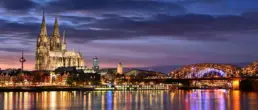31.07.2020 - 29.08.2020 - STORM | COLOGNE
ALEXANDER HÖLLER „STURM“ @ Galerie Martina Kaiser
Highly filigree ramifications and indissoluble braided structures embedded in luminous color contexts: There is something mystical about the works of Alexander Höller. Yet despite their ostensible impenetrability and their material as well as motivic roughness, they radiate an almost contemplative calm and sublimity.
It is the forest and its archaic vegetation patterns of roots, trunks, twigs and branches that provide the blueprint for the pictorial worlds of the 23-year-old Munich artist. And try to make bare complexity and original natural genius sensually tangible. With his neural network patterns, Alexander Höller refers not only to forest physics and natural intelligence, but also to his thought processes and sensations during the search for motifs and the genesis of images. His work thus stands in parallel for the visualization of metaphysical processes, emotions, affects, and mental and spiritual experiences, which are an essential part of his oeuvre.
With this, the recent graduate of the Munich Art Academy is in the tradition of the Romantics, where the soulfulness of nature and the genius loci as a spiritualized place led to a new representation of landscape views and natural phenomena. Which forms an exciting, almost contradictory contrast to the abstract expressionist, to which his paintings can be stylistically assigned. The exhibition title is also a homage to the literary epoch of the “Sturm und Drang”; emotio instead of ratio dominates the artist’s identity, the freedom of feeling is decisive for Höller’s abstracted forest portraits. In their dynamism and progressiveness, which sometimes seem to have an inner furor, they recall the action paintings of Jackson Pollock, just as Alexander Höller’s drawings hint at the influences of Franz Kline and Cy Twombly. With the subject of the German forest, Alexander Höller also follows in the footsteps of painters such as Kiefer, Lüpertz, and Baselitz, whose works have traced both the nimbus and the transfiguration of this stereotypical topos.
Like a storm, the Munich artist sweeps through art history and across the canvas, quoting, discarding, piling up and destroying in order to generate a new order. “The iconoclastic as a principle of deliberate discarding is part of my concept. And it leads to the fact that my pictures are created over a longer period of time, must first recover after an intervention, and then can continue to grow. Just like trees do after a storm,” says Alexander Höller. Thus, large formats can sometimes take several years of creation before Höller releases them.
At the beginning of his complex paintings are photos of tree formations, branch landscapes and root formations, which Alexander Höller then condenses in sketches and drawings into working principles. When transferring it to the canvas, he already has a finished picture in his head – and has to paint retrogradely, as it were, in all its layers, which are repeatedly sanded down over small or large areas, in order to allow the previously visualized to emerge successively from the lower diffuse levels.
In his object art entitled “Neurons,” the 23-year-old resorts to fluorescent cords, which he bundles into synapse-like networks, thus once again attempting to make understanding and comprehension, cognition and reception, and emotion and ratio visible.
(Author: Yorca Schmidt-Junker for Galerie Martina Kaiser)
Alexander Höller lives and works in Munich. He first attended the Academy of Fine Arts in Nuremberg and then transferred to the Academy of Fine Arts in Munich, where he received his diploma in February 2020. Already during his studies he could look back on exhibitions, among others in Regensburg, Karlsruhe and Heilbronn; recently sensational shows in Munich, Vienna and Miami were added. Alexander Höller’s works can be found in private collections worldwide, including those of many celebrities from business, culture and the media.
STURM
Offizielle Dokumentation über die Solo-Ausstellung "STURM" @ Galerie Martina Kaiser in Köln vom 31.07.2020 - 29.08.2020

Mit dem Laden des Videos akzeptieren Sie die Datenschutzerklärung von YouTube.
Mehr erfahren


